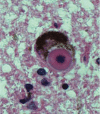Pathologic correlates of dementia in individuals with Lewy body disease
- PMID: 20522091
- PMCID: PMC2881486
- DOI: 10.1111/j.1750-3639.2009.00371.x
Pathologic correlates of dementia in individuals with Lewy body disease
Abstract
Cognitive impairment and dementia are more common in patients with Parkinson disease (PD) than age-matched controls and appear to become more frequent as PD progresses. However, estimates of dementia in patients with PD have varied widely, likely due in part to differences in case definition, case ascertainment and methodology. First, we review investigations of usual pathologic correlates of dementia in patients with brainstem (b) Lewy Body Disease (LBD) and report our findings from the initial 266 brain autopsies from a population-based study of brain aging and incident dementia. Our results showed that 2.6% of subjects were diagnosed with PD during life but that 20% had bLBD at autopsy. Seventy percent of individuals with bLBD had high level of one or more cerebral pathologic changes significantly associated with dementia: Alzheimer's disease (AD), cerebral (c) LBD or microvascular brain injury (microVBI); these were commonly co-morbid. Next we consider proposed contributors to cognitive impairment and dementia in the approximately 30% of patients with only bLBD, including regionally selective dendritic degeneration of neostriatal medium spiny neurons. Diseases contributing to cognitive impairment and dementia in patients with bLBD are heterogeneous, providing diagnostic challenges as well as multiple opportunities for successful intervention in patients with PD.
Figures




Similar articles
-
Temporal lobe atrophy on MRI in Parkinson disease with dementia: a comparison with Alzheimer disease and dementia with Lewy bodies.Neurology. 2005 Mar 8;64(5):861-5. doi: 10.1212/01.WNL.0000153070.82309.D4. Neurology. 2005. PMID: 15753423
-
A soluble tau fragment generated by caspase-2 is associated with dementia in Lewy body disease.Acta Neuropathol Commun. 2019 Jul 30;7(1):124. doi: 10.1186/s40478-019-0765-8. Acta Neuropathol Commun. 2019. PMID: 31362787 Free PMC article.
-
Cognitive impairment, decline and fluctuations in older community-dwelling subjects with Lewy bodies.Brain. 2012 Oct;135(Pt 10):3005-14. doi: 10.1093/brain/aws234. Brain. 2012. PMID: 23065790 Free PMC article.
-
What causes mental dysfunction in Parkinson's disease?Mov Disord. 2003 Sep;18 Suppl 6:S63-71. doi: 10.1002/mds.10565. Mov Disord. 2003. PMID: 14502658 Review.
-
A critical evaluation of current staging of alpha-synuclein pathology in Lewy body disorders.Biochim Biophys Acta. 2009 Jul;1792(7):730-40. doi: 10.1016/j.bbadis.2008.07.006. Epub 2008 Aug 5. Biochim Biophys Acta. 2009. PMID: 18718530 Review.
Cited by
-
Progressive parkinsonism in older adults is related to the burden of mixed brain pathologies.Neurology. 2019 Apr 16;92(16):e1821-e1830. doi: 10.1212/WNL.0000000000007315. Epub 2019 Mar 20. Neurology. 2019. PMID: 30894446 Free PMC article.
-
Advanced age, cardiovascular risk burden, and timed up and go test performance in Parkinson disease.J Gerontol A Biol Sci Med Sci. 2014 Dec;69(12):1569-75. doi: 10.1093/gerona/glu070. Epub 2014 May 26. J Gerontol A Biol Sci Med Sci. 2014. PMID: 24864306 Free PMC article.
-
Assessment of mild dementia with amyloid and dopamine terminal positron emission tomography.Brain. 2011 Jun;134(Pt 6):1647-57. doi: 10.1093/brain/awr089. Epub 2011 May 9. Brain. 2011. PMID: 21555336 Free PMC article.
-
Cerebrospinal fluid α-synuclein contributes to the differential diagnosis of Alzheimer's disease.Alzheimers Dement. 2018 Aug;14(8):1052-1062. doi: 10.1016/j.jalz.2018.02.015. Epub 2018 Mar 28. Alzheimers Dement. 2018. PMID: 29604263 Free PMC article.
-
Application of Cerebrospinal Fluid AT(N) Framework on the Diagnosis of AD and Related Cognitive Disorders in Chinese Han Population.Clin Interv Aging. 2021 Feb 22;16:311-323. doi: 10.2147/CIA.S294756. eCollection 2021. Clin Interv Aging. 2021. PMID: 33654388 Free PMC article.
References
-
- Aarsland D, Perry R, Brown A, Larsen JP, Ballard C (2005) Neuropathology of dementia in Parkinson's disease: a prospective, community‐based study. Ann Neurol 58:773–776. - PubMed
-
- Apaydin H, Ahlskog JE, Parisi JE, Boeve BF, Dickson DW (2002) Parkinson disease neuropathology: later‐developing dementia and loss of the levodopa response. Arch Neurol 59:102–112. - PubMed
-
- Bancher C, Braak H, Fischer P, Jellinger KA (1993) Neuropathological staging of Alzheimer lesions and intellectual status in Alzheimers and Parkinsons‐disease patients. Neurosci Lett 162:179–182. - PubMed
-
- Dickson DW, Braak H, Duda JE, Duyckaerts C, Gasser T, Halliday GM et al (2009) Neuropathological assessment of Parkinson's disease: refining the diagnostic criteria. Lancet Neurol 8:1150–1157. - PubMed
-
- Dorsey ER, Constantinescu R, Thompson JP, Biglan KM, Holloway RG, Kieburtz K et al (2007) Projected number of people with Parkinson disease in the most populous nations, 2005 through 2030. Neurology 68:384–386. - PubMed

